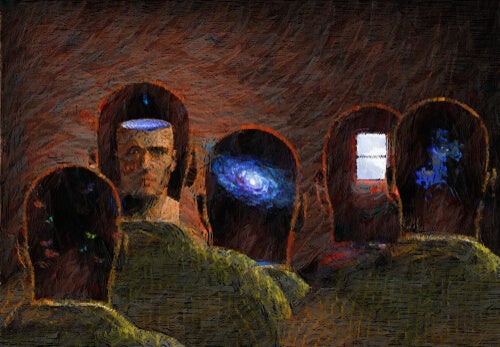4 Therapeutic Metaphors for Depression to Help You Reflect


Written and verified by the psychologist Valeria Sabater
Therapeutic metaphors for depression are often used in approaches such as acceptance and commitment therapy. The goal of these metaphors is to give the patient a different perspective on their situation and to allow them to analyze their reality in a deeper, more reflective, and original way.
However, we should point out that these linguistic resources won’t make the person overcome their depression overnight. It’s simply one more step, and one more strategy out of all the tools that a psychologist has at their disposal in order to help the therapeutic process with his patient.
That being said, it’s a very interesting tool to look at, and that’s what we’ll be doing in this article.
It’s a tool that, no matter the patient’s age, can awaken ideas, help a person face their situation, and often even break negative thought patterns.
Therapeutic metaphors in print
One of the true gurus of therapeutic metaphors is undoubtedly Sheldon Kopp. In his book Guru: Metaphors from a Psychotherapist, he gathers a wide range of these resources. George W. Burns also provides us with a more recent and in-depth work on this subject in his book Healing with Stories: Your Casebook Collection for Using Therapeutic Metaphors.
These types of strategies have been used for decades. In fact, Milton Erickson, a pioneer in the use of muscle relaxation and hypnosis in the therapeutic process, used to point out that, in his sessions, therapeutic metaphors were never missing.
He said that they were a way to “switch on” the patient’s mind and to place them in situations that could help them face things and make new discoveries to help them.

Therapeutic metaphors for depression
Before we look at therapeutic metaphors for depression in more detail, we should point out that, in some patients, they may not actually be useful. They won’t be if the patient suffers, for example, from major depression and is unable to listen, focus, or carry out a process of reflection.
Therefore, everything will depend on how the person is feeling at a given moment. This is something that the professional should evaluate. Let’s see what kind of metaphors can be useful in these cases.
1. The metaphor of the swamp
Imagine that your purpose in life is to reach the summit of a beautiful mountain. Now, when you begin your journey to that magical destination, you suddenly encounter an obstacle – a swamp. You fall into it, and your feet start to sink. You try to advance but you just sink deeper and deeper into that cold mud.
- Reflection⇒ In the journey of life, you’re forced to overcome obstacles. Depression is simply one more part of the path to your personal realization – to the top of that mountain. Whether you like it or not, you have to get out of that swamp to keep walking to the top. It’s one more process, one that you’ll end up achieving sooner or later with the help of therapy.
2. The metaphor of the gargoyle

Depression is like carrying a heavy gargoyle on your shoulders. A creature that constantly whispers to you how little you’re worth, and how dark everything around you is. It makes your thoughts more and more fatalistic. And the worst part is that that gargoyle never shuts up and drags you down more and more.
- Reflection⇒ You must remove that gargoyle from its position of power and influence over your life. That creature that whispers to you is actually your internal dialogue – a psychological dimension that you must begin to control and heal in order for it to work in your favor.
3. The light switch
Among all the therapeutic metaphors for depression, this one about a light switch is one of the most interesting ones. In this case, it also emphasizes the idea of negative thoughts. To understand it, you first need to think about a time that a light bulb has fused in some room in your house.
Every time you go into that room, your hand automatically reaches for the light switch to turn the light on. You know full well that it’s fused, but your brain tells you to hit the switch because it’s used to it.
- Reflection⇒ The same thing happens with depression. Your negative thoughts are also automatic. You activate them almost constantly. Thus, why not think and reflect on this metaphor and try to control them better?
4. The messages on my computer
Imagine that you sit down one day at your computer to do some work when something unusual happens. Suddenly, messages such as “You’re useless“, “Everything’s going to go wrong“, “You’ll always be unhappy“, “You deserve loneliness“, and “There’s no solution to your problems” start to appear on the screen. You, quite naturally, feel alarmed and scared.
You realize that it’s some sort of virus and that your computer is infected. However, far from trying to do something to stop it or asking for help to get rid of the virus, you just carry on trying to do your work.
You’ve so much you need to do, and other people are counting on you to deliver those reports and finish that work. Therefore, you put up with those messages while you try to carry out your work with great difficulty. After a couple of days, you feel totally inadequate. Those messages have totally undermined your spirit.
- Reflection⇒ Sometimes, you simply need to stop and ask for help. It doesn’t matter what others expect from you. It doesn’t matter what your job is, or the pressures that you’re under to deliver. When something isn’t right in your life, you should stop and ask for help. Putting off the problem will only increase the discomfort.

Conclusion
In conclusion, therapeutic metaphors for depression aren’t only useful for this psychological condition. In some way, they invite all of us to reflect and to look at our own personal situations from another perspective. They can be extremely powerful, so you should keep these resources in mind and take advantage of the benefits they can bring you.
All cited sources were thoroughly reviewed by our team to ensure their quality, reliability, currency, and validity. The bibliography of this article was considered reliable and of academic or scientific accuracy.
- Burns, G. (2009). Healing with Stories: Your Casebook Collection for Using Therapeutic Metaphors. Australian and New Zealand Journal of Family Therapy (Vol. 30, pp. 315–316). https://doi.org/10.1016/S0014-5793(99)00327-0
- David Gordon (1978) Metáforas terapéuticas para el cambio. Ariel
- Grinder, R. Bandler, R (1981) Trance-Formations. Explore Press
- Kopp, Sheldon (2009) Metáforas de un psicoterapeuta. Gedisa.
- Witztum, E., van der Hart, O., & Friedman, B. (1988). The use of metaphors in psychotherapy. Journal of Contemporary Psychotherapy, 18(4), 270–290. https://doi.org/10.1007/BF00946010
This text is provided for informational purposes only and does not replace consultation with a professional. If in doubt, consult your specialist.








